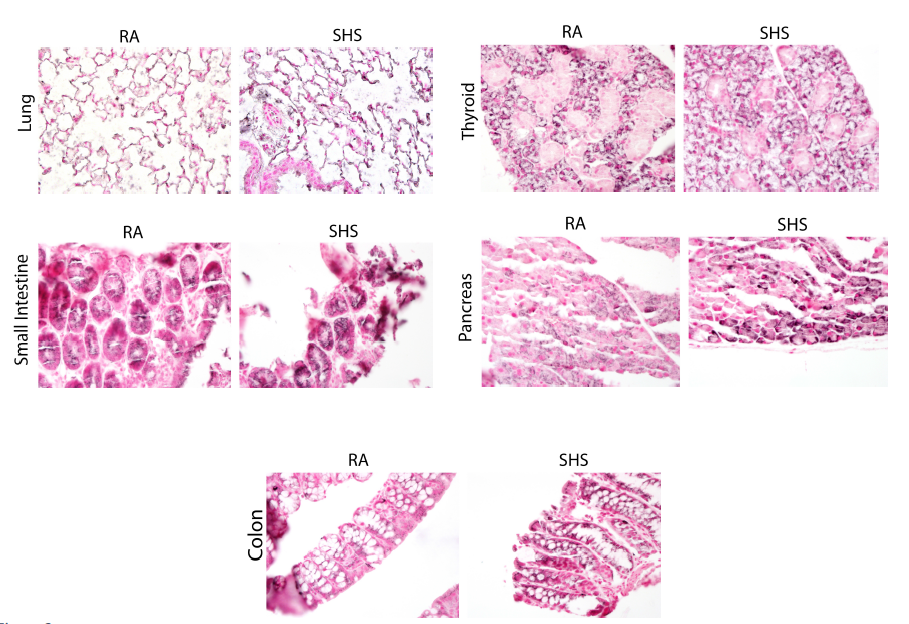Gassman, Jason
Spatial Expression of Receptor for Advanced Glycation End-Products (RAGE) in
Diverse Tissue and Organ Systems Differs Following Exposure to Secondhand
Cigarette Smoke
Faculty Mentor: Dr. Paul R. Reynolds, Department of Physiology and Developmental
Biology
Introduction
The receptor for advanced glycation end-products (RAGE) is a pattern recognition
receptor expressed in many cell types, including smooth muscle cells, fibroblasts,
macrophages, and epithelial cells (1). RAGE is capable of binding a variety of
endogenous ligands, included advanced glycation end-products (AGEs),
S100/calgranulins, amyloid-beta peptides, and HMGB1 (2). RAGE signaling has been
identified as a primary mediator in a variety of feed-forward inflammatory pathways and,
as such, has been implicated in a variety of chronic conditions of inflammation such as
chronic obstructive pulmonary disease (COPD), pancreatitis, and diabetic
cardiomyopathy (3-5).
Cigarette smoking has long been considered a significant risk factor for many
inflammatory diseases of the lung, and recent investigation has shown that RAGE
upregulation plays an important role in perpetuating the pro-inflammatory response.
Consequently, RAGE has become a potential target for protective and therapeutic
modalities against the deleterious effects of cigarette smoke (6). However, little
research has been undertaken to identify the effects of cigarette smoke on RAGE levels
and the subsequent inflammatory response in regions of the body distal to the lung. In
the present study, we sought to characterize the expression profile of RAGE in a variety
of peripheral tissues and organs in response to exposure to secondhand cigarette
smoke.
Methodology
Wild-type (WT) mice were exposed to secondhand cigarette smoke (SHS) twice a day
for ten minutes over the course of 60 days using a nose-only exposure system. A
control group of WT mice were exposed to room air (RA) under identical experimental
conditions. After 60 days, the mice were sacrificed and their tissues were collected for
analysis via real-time polymerase chain reaction, immunoblot, and
immunohistochemistry.
Results
RAGE expression levels in samples exposed to SHS were analyzed at the mRNA (fig.
1) and protein levels (data not shown) and were compared to baseline RAGE
expression in control samples. The results were tissue-specific. In many tissues, such
as heart, pancreas, brain, skeletal muscle, and eye, RAGE expression appears to be
upregulated. Conversely, other tissue types, such as the liver, showed a downregulation
in RAGE expression, while others exhibited little variability in RAGE levels in response
to SHS exposure. Immunohistochemistry was performed to qualitatively visualize the
spatial expression pattern in several of the organs and tissues (fig. 2).
In general, RAGE upregulation implicates the receptor as a pro-inflammatory mediator
(7). Our data show that RAGE levels throughout the body vary after secondhand
cigarette smoke exposure, indicating that RAGE may be differentially regulated in
response to deleterious stimuli. These data may provide the groundwork for further
investigation into the mechanisms and pathways of RAGE regulation in peripheral
regions of the body and, in the case of RAGE upregulation, the extent and effects of the
induced inflammatory response.
Scholarly Sources
1. Neeper M, Schmidt AM, Brett J, Yan SD, Wang F, Pan YC, Elliston K, Stern D,
Shaw A. 1992. Cloning and expression of a cell surface receptor for advanced
glycosylation end products of proteins. J Biol Chem. 267(21):14998-5004.
2. Thornalley PJ. 1998. Cell activation by glycated proteins. AGE receptors,
receptor recognition factors and functional classification of AGEs. Cell Mol Biol.
44(7):1013-23.
3. Wu L, Ma L, Nicholson LF, Black PN. 2011. Advanced glycation end products
and its receptor (RAGE) are increased in patients with COPD. Respir Med.
105(3):329-36.
4. Kang R, Chen R, Xie M, Cao L, Lotze MT, Tang D, Zeh HJ 3rd. 2016. The
Receptor for Advanced Glycation End Products Activates the AIM2
Inflammasome in Acute Pancreatitis. J Immunol. 196(10):4331-7.
5. Ma H, Li SY, Xu P. Babcock SA, Dolence EK, Brownlee M, Li J, Ren J. 2009.
Advanced glycation endproduct (AGE) accumulation and AGE receptor (RAGE)
up-regulation contribute to the onset of diabetic cardiomyopathy. 2009. J Cell Mol
Med. 13(8B):1751-64.
6. Sukkar MB, Ullah MA, Gan WJ, Wark PA, Chung KF, Hughes JM, Armour CL,
Phipps S. 2012. RAGE: a new frontier in chronic airways disease. Br J
Pharmacol. 167(6):1161-76.
7. Chuah YK, Basir R, Talib H, Tie TH, Nordin N. 2013. Receptor for advanced
glycation end products and its involvement in inflammatory diseases. Int J Inflam.
2013:403460.


